› Forums › Spectroscopy › Spectroscopes
- This topic has 16 replies, 4 voices, and was last updated 6 years, 4 months ago by
 Robin Leadbeater.
Robin Leadbeater.
-
AuthorPosts
-
5 July 2019 at 3:14 pm #574358
 Tony RoddaParticipant
Tony RoddaParticipantHi guys,
Just to let everyone know I’ve been keeping busy during these long light summer days & nights.
Photos attached of recently finished spectroscopes and asociated ‘stuff’.
The fully clad Tragos in it’s finished rigid body; the Paul Gerlach designed Lowspec2, mounted on-scope complete with aluminium tape coat; the new Christian Buil UVEX3, accompanied by a printed guider under testing; and, a ‘calibration unit’ built with a miniture circuitry that generates 400V from a PP3 9v battery, halogen flat bulb and ‘different’ “Relco” bulbs that I’ve found.
Anyway, I now have more spectroscopes than I’ve had clear, usable, nights in the last two months. I’m going on my hols soon so they’ll all occur then…
Regards
T
The Tragos…
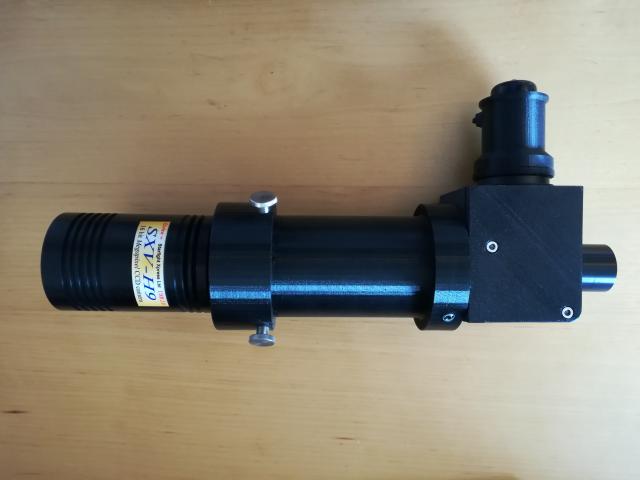
The Lowspec2 on the bench…

Lowspec2 mounted…
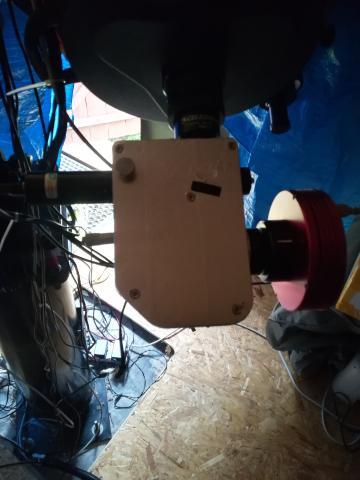
Lowspec2 under initial tests…

UVEX3 with guider…
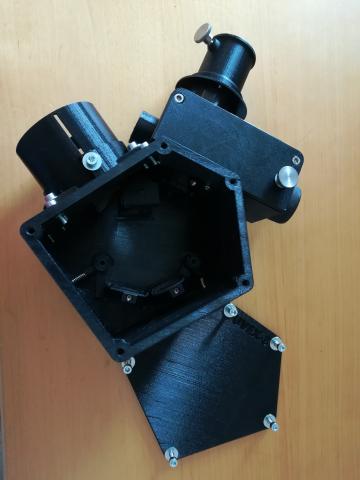
Calibration and ‘Flat’ unit…

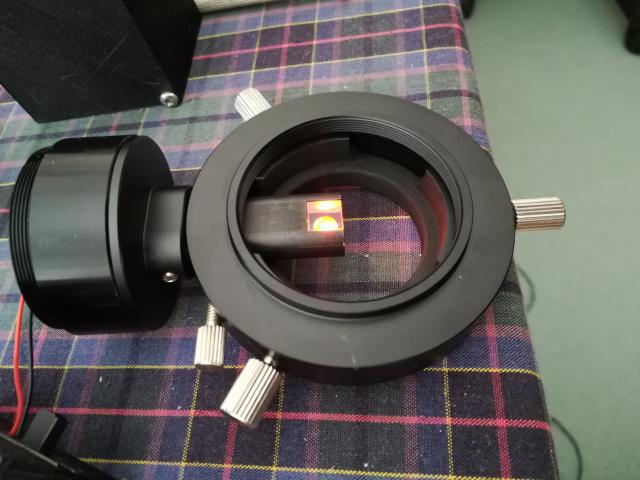 6 July 2019 at 10:37 am #581183
6 July 2019 at 10:37 am #581183 Robin LeadbeaterParticipant
Robin LeadbeaterParticipantLooking forward to seeing how faint the TRAGOS might go. It could potentially be a nice alternative to the modded ALPY 200 for supernova work. (I have had some interest but copying it has been thwarted due the the unavailabity of the 200l/mm grism) What resolving power will your TRAGOS give ?
Robin
7 July 2019 at 7:36 pm #581190 Tony RoddaParticipant
Tony RoddaParticipantHi Robin,
It sould be around R=400 @550nm for the 23um slit.
Vadim Burwitz got 350 with a much larger pixel camera.
Here’s a quick neon test run.
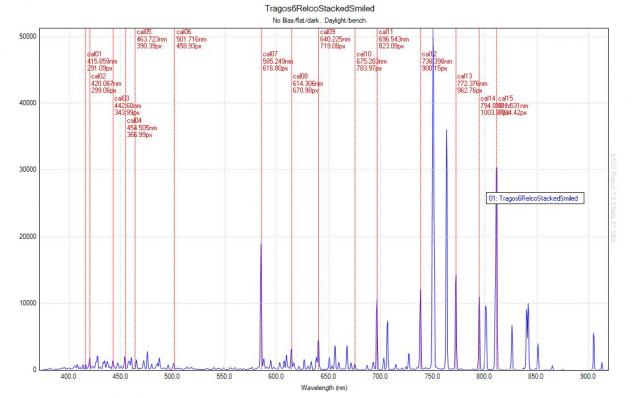
Regards
T
7 July 2019 at 8:15 pm #581191 Robin LeadbeaterParticipant
Robin LeadbeaterParticipantAh OK, a bit high for really faint objects but I guess the SA200 could be swapped for an SA100? Are you using the PH wedge prism?
8 July 2019 at 10:05 am #581192 Tony RoddaParticipant
Tony RoddaParticipantNo, I experimented with Thorlabs 4, 7 and 11 degree prisms and settled on the 6. (I think the PH is 4 degrees?).
The “11” worked best but deviated the beam too much for my SXVH9 camera chip. A bigger camera would probably work but I couldn’t retask my Atik460.
Anyway, the easiest assembly method is to use standard eyepiece holders/spacers and just screw the four components together! An optical train of 50mm collimating lens, prism, grating and 80mm camera lens as per Burwitz’s design. A guider at one end (Paul Gerlach’s works well) and an camera connector at the other such as a T2/1.25″ nosepiece type. All that’s needed is a printed tube/jacket so that the assembly can be rotated/focused at each end (to align the prism/grating with the slit and the camera).
Having built it I now know what needs putting right (!) and I’m redesigning the optics holders and guider. I’ll ‘publish’ the stl files in a couple of weeks.
Regards
T
8 July 2019 at 11:48 am #581193 Robin LeadbeaterParticipant
Robin LeadbeaterParticipantYes the “junk box” approach is a simple alternative to 3D printing these “linear” transmission spectrograph designs. eg
http://www.threehillsobservatory.co.uk/astro/spectroscopy_19.htm
http://www.threehillsobservatory.co.uk/astro/spectroscopy_18.htm
though I never got round to coupling them to the ALPY mirror slit guider
Claudio Balcon in Italy has recently classified a couple of faint supernovae using a similar home built collimated Star Analyser 100 setup
11 August 2019 at 3:24 pm #581248 Derek RobsonParticipant
Derek RobsonParticipantSupernovae can be seen visually. So what extra does spectroscopy do? Is it that spectra of supernovae can be used to classify them, in a similar way that spectra of stars can classify the stars into certain spectral types?
When a stars goes supernovae, is there a change in spectra (composition wise) before and after?
11 August 2019 at 10:47 pm #581249 Robin LeadbeaterParticipant
Robin LeadbeaterParticipantHi Derek
Not all candidate supernovae turn out to be supernovae, for example they may turn out to be novae, Luminous Blue Variable outbursts or other cataclysmic variables in our own galaxy. A follow up spectrum is needed to establish exactly what type of object it is. (For example the redshift measurement can be used to confirm if it is extra-galactic and the width of the lines can be used to measure the velocity of the material flung out in the explosion which is much higher for supernovae.There are also different types of supernovae produced by different mechanisms, for example core collapse of massive stars or the thermo-nuclear explosion of a white dwarf following accretion of material from a companion. These different types of event have characteristic spectral features and are very different from what the spectrum would have been before the explosion.
An introductory paper on the subject is one by Filippenko here
https://ned.ipac.caltech.edu/level5/March03/Filippenko/frames.html
also brief but more up to date this blog entry
https://astrobites.org/2016/12/02/classifying-supernovae/
I have talked more about this and how I am using spectroscopy to confirm and classify supernovae spectroscopically in more detail in a few BAA meetings a couple of which were videoed
https://britastro.org/video/11250/12234
https://britastro.org/video/13862/14769
Also short more up to date piece on the Sky and Telescope website currently
Cheers
Robin
24 August 2019 at 11:57 pm #581302 Derek RobsonParticipant
Derek RobsonParticipantHi Robin.
Thanks for all that, some more readings and videos.
“These different types of event have characteristic spectral features and are very different from what the spectrum would have been before the explosion.”
It would be someone’s lucky day had they just recently randomly acquired data on a random star before and then heard of an event, then went to analyse it again on the same kit. But then, there would probably be no reason to have targeted though, unless there had been suggestions of activity.
Derek
25 August 2019 at 4:11 pm #581304 Robin LeadbeaterParticipant
Robin LeadbeaterParticipantThere are cases of stars which have had previous outbursts and then gone supernova, as in this one found by Ron Arbour
https://britastro.org/node/17595
Cheers
Robin
25 August 2019 at 4:12 pm #581303 Robin LeadbeaterParticipant
Robin LeadbeaterParticipantYes extra galactic supernova progenitors are just faint stars among billions so until we get another supernova in our own galaxy, there are very few observations of supernova progenitors, mostly found in deep images eg archive HST images. All are of core collapse types as they are produced by luminous stars eg supergiant and Wolf Rayet stars, for example
https://www.spacetelescope.org/images/opo1847b/
The progenitor of sn 2017ein discovered by Ron Arbour
Robin
25 August 2019 at 8:52 pm #581305 Dr Paul LeylandParticipant
Dr Paul LeylandParticipantAre you sure that the same star was involved?
My understanding, which may well be wrong, is that the objects concerned were very close together on the sky but it’s far from certain that they were identically the same object.
A better example, perhaps, might by SN 1987A, aka Sanduleak -69 202. There is absolutely no doubt there that the SN precursor had been studied by Sanduleak.
26 August 2019 at 11:18 am #581309 Dr Paul LeylandParticipant
Dr Paul LeylandParticipantI don’t know of any reported variability of Sk -69 202. I’d be mildly surprised if it wasn’t variable.
A good number of LBVs are accessible to amateur observation. AE And and AF And are on my observing program. Eventually I’ll take a look at others in M31 and make start on those in M33. It’s a shame that the LMC and SMC never rise here.
Your mission, Robin, should you choose to accept it, is to take spectra of AE & AF And. This post will self-destruct in five seconds.
😉
26 August 2019 at 11:39 am #581306 Robin LeadbeaterParticipant
Robin LeadbeaterParticipantYes the progenitor of the LMC supernova SN 1987A, Sanduleak -69 202 had been catalogued spectroscopically as a blue supergiant prior to it going supernova. I am not aware of any observed outbursts before it exploded though.
If 2010oct and 2017ein (correction 201oct and 2019cda) don’t turn out to be the same object then other examples of impostors apparently later exploding for real as supernovae are 2006jc and 2009ip
26 August 2019 at 12:23 pm #581310 Robin LeadbeaterParticipant
Robin LeadbeaterParticipantIf you are interested in following a white dwarf binary system that might “soon” become a type 1a supernova then M31N 2008-12a could be a good bet. Matt Darnley talked about it at NAM this year
https://nam2019.org/thursday/details/23/327
https://nam2019.org/thursday/details/23/445
Robin
26 August 2019 at 2:18 pm #581312 Dr Paul LeylandParticipant
Dr Paul LeylandParticipantThanks. I may well add it to my program later this year once the imaging problems are worked out. Just found https://arxiv.org/abs/1607.08082 which contains a finder chart and a comparison sequence. I will investigate further.
Do you have any recent literature references to hand?
26 August 2019 at 5:22 pm #581313 Robin LeadbeaterParticipant
Robin LeadbeaterParticipantI am not a member of the “12a Collaboration” but there must be some of the VSS Section who are on here. If not, I am sure an email to Dr Matt Darnley at LJMU would bring you up to speed if you want to join the collaboration.
Cheers
Robin
-
AuthorPosts
- You must be logged in to reply to this topic.
